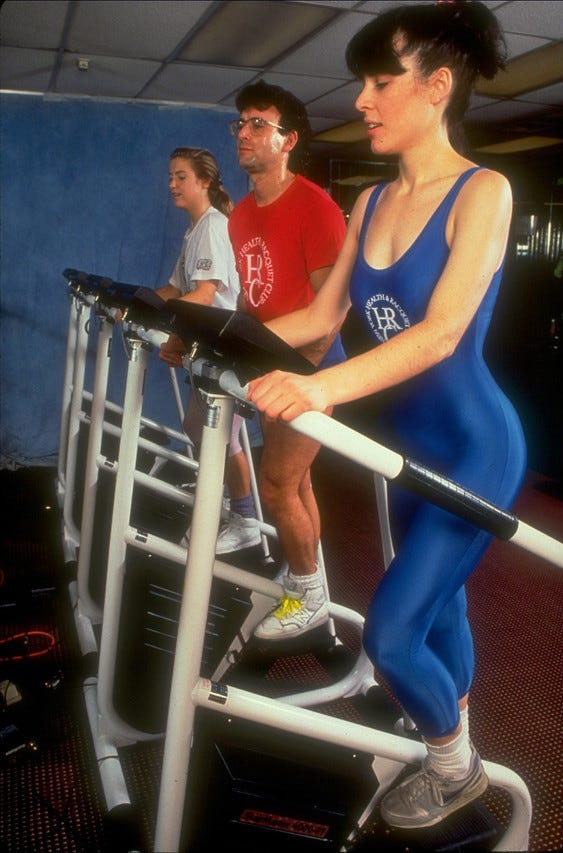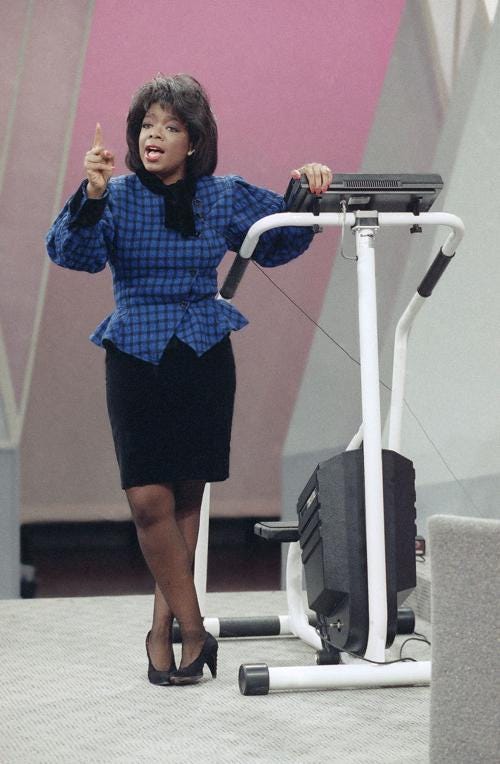
George Schupp never expected to find himself in Robert De Niro’s apartment. Once the owner of a thriving a custom manufacturing company in Tulsa, Schupp’s business withered during the 1970s energy crisis.
Feeling aimless, Schupp and his business partner, Jim Walker, began wondering what else they could manufacture. Through creativity and fate, they ended up producing something so iconic that it transformed gyms around the world – and sculpted countless butts along the way.
Maybe that’s what De Niro was hoping for, when he invited Schupp into his home. It’s hard to know, all these years later. But the one thing the story shows is that even De Niro wasn’t immune to the allure of the StairMaster.

For a long time, gyms didn’t have machines, other than a stationery bike or two. The gym was a place for synchronized cardio classes, or free weights. The StairMaster, along with companies like Nautilus, transformed the gym into its current landscape, where rows of treadmills coexist with bikes, ellipticals and other contraptions.
But how did the StairMaster climb from its humble Midwest origins to an Oscar-winning actor’s luxurious suite? It started with a chance encounter. In the midst of Schupp and Walker’s strategizing over how to transition into the fitness industry, they happened to meet a man named Lanny Potts.
When Walker showed up to buy Potts’ old car, the two fell into a meet cute so perfect it could have been scripted. Potts, it turned out, was an inventor. Soon, the trio met regularly to brainstorm. Walker and Schupp had the manufacturing know-how, and Potts brought promising ideas into the mix.
Seeking inspiration, Potts began reaching out to friends and associates. At one point, he made the fateful decision to approach his doctor, who proceeded to muse about the vexing problem of stair climbing. Did they know that climbing is excellent exercise, yet the descent can wreak havoc on shins and joints? They did not. But there it was, nearly perfect: A problem that needed a solution. And so they got to work.
In this way, the StairMaster’s history is almost the exact opposite of the treadmill’s. While the StairMaster is designed to minimize potential injury, the treadmill was specifically designed to inflict it. In 1818, a civil engineer named William Cubitt designed the treadmill as a ghoulish machine to punish prisoners.
Incarcerated individuals would be sent to this early version of the treadmill for hours at a time, ostensibly to pump water or process grain. Really, the treadmill was designed to crush their spirits. Always in motion, yet never allowing forward progress, the treadmill was designed to maximize boredom. The prisoners who were forced to use it suffered countless injuries, physical and psychic. Eventually, the treadmill was shelved for being too cruel.
By paving the way for more gym machines, the StairMaster also redefined how treadmills factor into workouts. But the element of extreme physical challenge remained. “Just climbing, overcoming the weight of gravity on a slow climb — which was eventually the case, because the breaking was fine-tuned — is just a grueling workout,” recalls Ralph Cissne, the StairMaster’s original director of marketing.
Before long, StairMaster’s small team made a name for themselves at national trade shows. Looking back on them, Cissne remembers being at the center of a mob. Their strategy was understated. “All we have to do is get people on the machine, get them to experience the workout, and take their order,” Cissne says.
This hit a fever pitch when StairMaster introduced a lighter, sleeker model. The StairMaster 4000 Personal Trainer hit stores in 1986, kicking off an explosion of press coverage. “We were shipping something like, oh, 1,500 a month, something like that,” Schupp says.
A gyms, lines of impatient climbers waited while trainers instituted time limits to enforce sharing. Reading the list of Hollywood stars addicted to their 4000 PTs is like scanning a marquee: Tom Cruise, Shirley MacLaine, Tom Selleck, Jim Belushi, Vanna White. The 4000 PT started popping up on movie sets so stars could squeeze in an extra workout or two. Even Oprah was dedicated to her StairMaster, frequently mentioning the machine on her show. She even gave it a nickname: “My little friend.”

All these years later, the design has remained as steady as the StairMaster’s patient revolving steps. Sometimes an idea arrives in the world, fully formed, not in need of improvement. That seems to be how Potts’ design has functioned.
As for me, I trek to my gym three or four times a week and head straight for my favorite treadmill. It’s wedged in the middle of a row of machines, next to a StairMaster that always towers over me.
Maybe one of these days I’ll give it a try.
If you’re interested in learning more about the StairMaster, I cannot recommend Andy Wright’s oral history of the invention, published earlier this year on Elemental. It was the main source for this newsletter, which only scratched the surface of how fascinating the story is.
Something else
It’s almost Thanksgiving, which means it’s already Christmas on the Hallmark Channel. Ever year, I look forward to shutting my computer and spending a day or two in front of my parent’s TV with a slice of leftover birthday cake (I’m turning 27!) and a cup of tea while an endless parade of soapy movies washes over me.
You can find the full list of 40 (!) new movies here.


